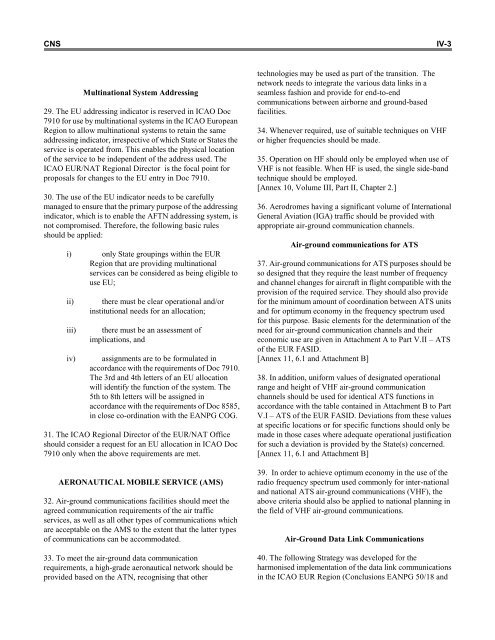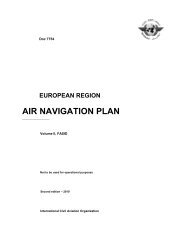7754 Vol 1 Flyleaf - ICAO Public Maps
7754 Vol 1 Flyleaf - ICAO Public Maps
7754 Vol 1 Flyleaf - ICAO Public Maps
Create successful ePaper yourself
Turn your PDF publications into a flip-book with our unique Google optimized e-Paper software.
CNS IV-3<br />
Multinational System Addressing<br />
29. The EU addressing indicator is reserved in <strong>ICAO</strong> Doc<br />
7910 for use by multinational systems in the <strong>ICAO</strong> European<br />
Region to allow multinational systems to retain the same<br />
addressing indicator, irrespective of which State or States the<br />
service is operated from. This enables the physical location<br />
of the service to be independent of the address used. The<br />
<strong>ICAO</strong> EUR/NAT Regional Director is the focal point for<br />
proposals for changes to the EU entry in Doc 7910.<br />
30. The use of the EU indicator needs to be carefully<br />
managed to ensure that the primary purpose of the addressing<br />
indicator, which is to enable the AFTN addressing system, is<br />
not compromised. Therefore, the following basic rules<br />
should be applied:<br />
i) only State groupings within the EUR<br />
Region that are providing multinational<br />
services can be considered as being eligible to<br />
use EU;<br />
ii) there must be clear operational and/or<br />
institutional needs for an allocation;<br />
iii) there must be an assessment of<br />
implications, and<br />
iv) assignments are to be formulated in<br />
accordance with the requirements of Doc 7910.<br />
The 3rd and 4th letters of an EU allocation<br />
will identify the function of the system. The<br />
5th to 8th letters will be assigned in<br />
accordance with the requirements of Doc 8585,<br />
in close co-ordination with the EANPG COG.<br />
31. The <strong>ICAO</strong> Regional Director of the EUR/NAT Office<br />
should consider a request for an EU allocation in <strong>ICAO</strong> Doc<br />
7910 only when the above requirements are met.<br />
AERONAUTICAL MOBILE SERVICE (AMS)<br />
32. Air-ground communications facilities should meet the<br />
agreed communication requirements of the air traffic<br />
services, as well as all other types of communications which<br />
are acceptable on the AMS to the extent that the latter types<br />
of communications can be accommodated.<br />
33. To meet the air-ground data communication<br />
requirements, a high-grade aeronautical network should be<br />
provided based on the ATN, recognising that other<br />
technologies may be used as part of the transition. The<br />
network needs to integrate the various data links in a<br />
seamless fashion and provide for end-to-end<br />
communications between airborne and ground-based<br />
facilities.<br />
34. Whenever required, use of suitable techniques on VHF<br />
or higher frequencies should be made.<br />
35. Operation on HF should only be employed when use of<br />
VHF is not feasible. When HF is used, the single side-band<br />
technique should be employed.<br />
[Annex 10, <strong>Vol</strong>ume III, Part II, Chapter 2.]<br />
36. Aerodromes having a significant volume of International<br />
General Aviation (IGA) traffic should be provided with<br />
appropriate air-ground communication channels.<br />
Air-ground communications for ATS<br />
37. Air-ground communications for ATS purposes should be<br />
so designed that they require the least number of frequency<br />
and channel changes for aircraft in flight compatible with the<br />
provision of the required service. They should also provide<br />
for the minimum amount of coordination between ATS units<br />
and for optimum economy in the frequency spectrum used<br />
for this purpose. Basic elements for the determination of the<br />
need for air-ground communication channels and their<br />
economic use are given in Attachment A to Part V.II – ATS<br />
of the EUR FASID.<br />
[Annex 11, 6.1 and Attachment B]<br />
38. In addition, uniform values of designated operational<br />
range and height of VHF air-ground communication<br />
channels should be used for identical ATS functions in<br />
accordance with the table contained in Attachment B to Part<br />
V.I – ATS of the EUR FASID. Deviations from these values<br />
at specific locations or for specific functions should only be<br />
made in those cases where adequate operational justification<br />
for such a deviation is provided by the State(s) concerned.<br />
[Annex 11, 6.1 and Attachment B]<br />
39. In order to achieve optimum economy in the use of the<br />
radio frequency spectrum used commonly for inter-national<br />
and national ATS air-ground communications (VHF), the<br />
above criteria should also be applied to national planning in<br />
the field of VHF air-ground communications.<br />
Air-Ground Data Link Communications<br />
40. The following Strategy was developed for the<br />
harmonised implementation of the data link communications<br />
in the <strong>ICAO</strong> EUR Region (Conclusions EANPG 50/18 and














